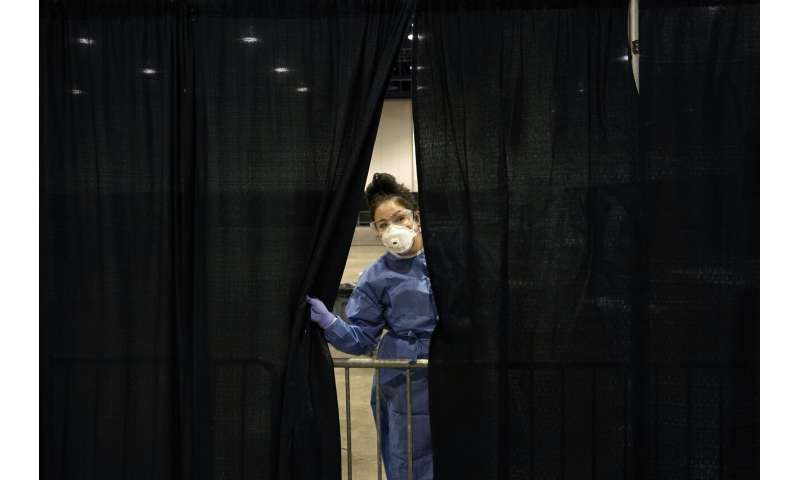
Big house parties, no-mask weddings, crowded bars and restaurants—there are reasons the U.S. has racked up more than 155,000 coronavirus deaths, by far the most of any country, and is fast approaching an off-the-charts 5 million confirmed infections, easily the highest in the world.
Many Americans have resisted wearing masks and social distancing, calling such precautions an over-the-top response or an infringement on their liberty. Public health experts say such behavior has been compounded by confusing and inconsistent guidance from politicians and a patchwork quilt of approaches to containing the scourge by county, state and federal governments.
“The thing that’s maddening is country after country and state after state have shown us how we can contain the virus,” said Dr. Jonathan Quick of the Duke Global Health Institute, who is leading a pandemic initiative for the Rockefeller Foundation. “It’s not like we don’t know what works. We do.”
The number of confirmed infections in the U.S. has topped 4.7 million, with new cases running at over 60,000 a day. While that’s down from a peak of well over 70,000 in the second half of July, cases are rising in 26 states, many in the South and West, and deaths are climbing in 35 states.
On average, the number of COVID-19 deaths per day in the U.S. over the past two weeks has gone from about 780 to 1,056, according to an Associated Press analysis.

In Massachusetts, health officials are investigating at least a half-dozen new clusters of cases connected to such events as a lifeguard party, a high school graduation party, a prom party, an unsanctioned football camp and a packed harbor cruise trip.
One recent house party on Cape Cod has led to more than a dozen new cases and prompted some restaurants to close or limit service at the height of tourist season because workers had attended the gathering.
Elsewhere around the state, a Springfield hospital is dealing with an outbreak of more than 40 cases linked to a staffer who recently returned from an out-of-state vacation and spread the virus to colleagues while eating lunch in a break room.
Hot spots around the U.S. are popping up in what once seemed like ideal places to ride out the outbreak: rural, less populated and with lots of outdoor space. In South Dakota, a spike erupted at a Christian youth summer camp in the Black Hills, with cases growing to 96 among 328 people who attended.
“We’re at a point where there’s enough spread of COVID-19 that people throughout the U.S. are at an increased likelihood of encountering the virus and getting exposed,” University of Florida epidemiologist Dr. Cindy Prins said.

She added: “This is a behavioral disease right now for a lot of people.” Prevention means “changing our behavior and it’s so hard for humans to do. We’re social creatures.”
President Donald Trump’s public pronouncements during the crisis have been infused with an optimism at odds with the facts on the ground. In April, he assured Americans that “we have passed the peak in new cases, we are starting our life again.” In May, as the death toll surpassed 80,000, he declared the country had “met the moment and we have prevailed.”
In Virginia, cases have surged so much in cities like Norfolk and Virginia Beach that Democratic Gov. Ralph Northam placed limits last week on the region’s alcohol sales and gatherings of more than 50 people. Northam, the nation’s only governor who is a doctor, cited rising infections among young people and said the problem is that “too many people are selfish.”
“We all know that alcohol changes your judgment,” he said. “You just don’t care as much about social distancing after you’ve had a couple of drinks. That’s when the virus gets spread.”
Dr. Demetria Lindsay, the Virginia Department of Health’s district director for Virginia Beach and Norfolk, said there has been a pronounced spike among people ages of 20 to 29. She said factors behind the surge include gatherings of people not wearing masks or keeping a safe distance.

“Father’s Day, Memorial Day, graduations, birthdays, backyard barbecues, you name it,” Lindsay said.
Nearly a quarter of Wisconsin’s more than 55,000 total cases had been confirmed over the past 14 days. Much of the spike has occurred in the state’s densely urban southeastern corner, but the disease has also spread with amazing speed in rural and sparsely populated northern Wisconsin.
Zona Wick, a spokeswoman and contact tracer for Iron County’s health department, blamed the surge on Fourth of July gatherings, birthday and graduation parties, out-of-county visitors and people crowding into bars.
“The Fourth of July was tough on us,” Wick said. “People had a bit of quarantine fatigue, is what I’m calling it. People got a bit tired of staying in. People just got together like they have for years on the Fourth of July and spread it to one another.”
The numbers are even more sobering in Barron County, a county of 45,000 people about 75 miles northeast of Minneapolis. As of Monday, it had seen 259 confirmed cases, more than 70% of them in just the last two weeks.

Sarah Turner, a public health specialist with the county, attributed much of the spike to an outbreak at a food processing plant but also cited crowded bars and family gatherings.
“We were hoping that being rural and being more spread out” would protect the county, “but that’s proving not to be the case,” she said. “Like everywhere and anywhere right now, there are people who don’t buy into health measures. It’s a little bit of out-of-sight, out-of-mind. People don’t take it seriously when it’s not in your face.”
The wedding industry likewise is seeing no-mask receptions with busy dance floors and no social distancing.
Wedding planner Lynne Goldberg has a December wedding scheduled for 200 guests at the home of the bride’s parents in upstate New York.
Source: Read Full Article


